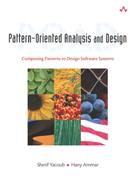Book Description
Design patterns are immensely powerful, but to build large-scale robust systems, you need more. Pattern-Oriented Analysis and Design introduces a methodology for "composing" proven design patterns into reliable, robust large-scale software systems. Using POAD, you can quickly build systems that are far more robust, scalable, and maintainable-using UML class diagrams as your building blocks.
POAD: What it is, how it works, and what problems it solves
Structural and behavioral approaches to design pattern composition
Design models and UML techniques for pattern composition
POAD processes: in depth coverage of analysis, design, and design refinement
A systematic process to compose design patterns
4 chapter-length case studies: feedback control, customer behavior simulation, digital content processing, and distributed medical informatics
Building on POAD: advanced trends and research
Pattern-Oriented Analysis and Design takes design patterns to the next level. Whether you're an architect, designer, developer, or manager, it will help you build better software systems faster.
Table of Contents
- Copyright
- Preface
- Foreword
- I. Introduction
- 1. Pattern-Oriented Analysis and Design
- 2. Design Patterns and Software Engineering
- 3. Composition of Design Patterns
- II. Technological Aspects of POAD
- 4. Constructional Design Patterns as Components
- 5. Visual Design Models
- 6. UML Support for Design Patterns
- III. Process Aspects of POAD
- 7. POAD: The Process
- 8. Analysis Phase
- 9. Design Phase
- 10. Design-Refinement Phase
- IV. Case Studies
- 11. Feedback Control Systems
- 12. Simulation of Waiting Queues
- 13. A Digital Content Remastering Application
- Document Understanding
- Pattern-Oriented Analysis and Design for the Distribution Subsystem
- Pattern-Oriented Analysis and Design for the Filtering Subsystem
- Summary
- 14. A Medical Informatics System
- Medical Informatics Standards
- Digital Imaging and Communication in Medicine (DICOM)
- Pattern-Oriented Analysis and Design of the DICOM UL
- Pattern-Oriented Analysis and Design for the Client Application Entity
- Summary
- V. Automation and Summary
- 15. Relation to UML Metamodel and Specification
- 16. Tool Support for Designing with Patterns
- 17. Wrapping Up
- A. Interfaces for Constructional Design Patterns
- B. State of the Art and Practice in Design Patterns
- Glossary
- Bibliography
